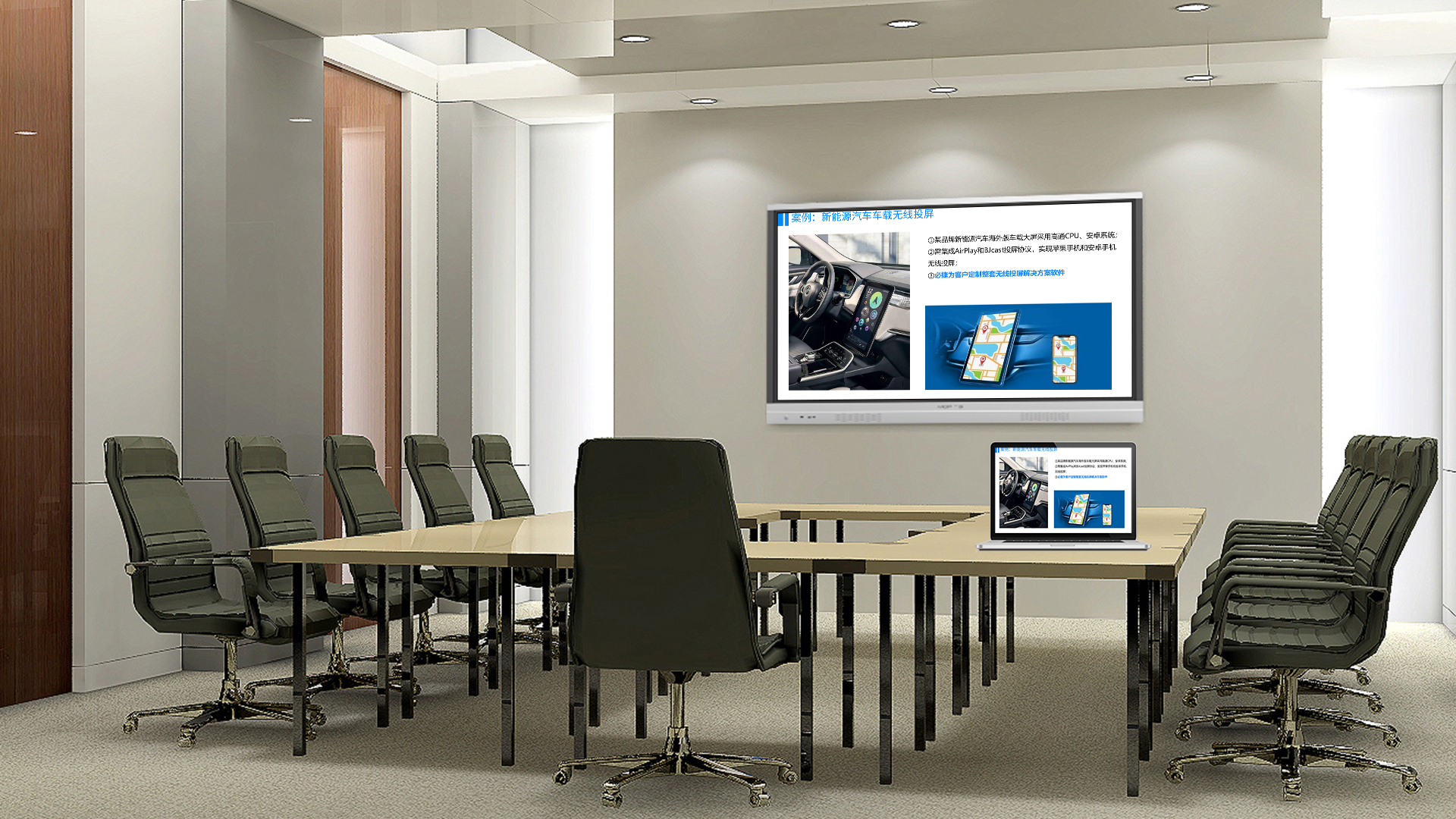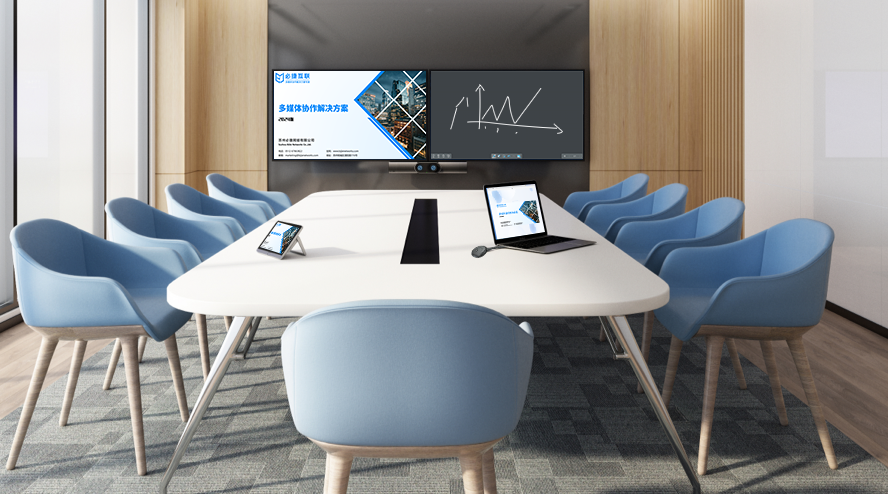DLNA: More Flexible Targeted Screen Mirroring
Tired of screen mirroring issues like “full-screen mirroring occupying device resources and imprecise material casting”? This screen mirroring device is deeply compatible with the DLNA protocol! No need for full-screen synchronization—it supports targeted casting of documents, videos, and audio from computers or mobile phones to large screens. Covering scenarios such as office presentations, home entertainment, and training sessions, it transforms screen mirroring from “full-content synchronization” to “on-demand casting,” enabling more efficient multi-tasking.
2-Step Activation of Targeted Streaming, Zero Operational Threshold
No complex settings—follow these steps for precise casting:
- Quick Device Connection: Connect the screen mirroring receiver to a large screen (meeting screen/TV/projector) and power it on. The large screen will display an exclusive DLNA identification name (e.g., “Living Room DLNA Screen,” “Meeting Room 1 Screen”). Connect the casting device (computer/mobile phone) to the same network as the screen mirroring device—no drivers or plug-ins required.
- Cast by Selecting Materials: On a computer, right-click on a document, video, or audio file, select “Play to Device,” and choose the large screen name corresponding to the screen mirroring device. On a mobile phone, in file management or playback software, tap the “DLNA Cast” icon and select the device. Casting is completed in 1 second, and after casting, the device can be freely used for other functions.
Core Advantages: DLNA Screen Mirroring Meets Actual Needs
Targeted Casting Saves Device Resources, Enabling Multi-Tasking
Unlike full-screen mirroring, DLNA only casts specified materials (e.g., PPTs, MP4 videos, MP3 audio). After casting from a computer/mobile phone, you can edit documents in the background, reply to work messages, or browse materials—your screen won’t be occupied by mirrored content, allowing you to balance work and entertainment.It supports simultaneous targeted streaming from multiple devices. For example, a computer can cast a PPT to a meeting screen while a mobile phone casts a reference video to a secondary screen. Dual-screen complementary display makes information delivery more three-dimensional without mutual interference.
Full Format Compatibility, Unobstructed Material Casting
Perfectly compatible with mainstream formats under the DLNA protocol: document formats (PPT, PDF, Word, Excel), video formats (MP4, MKV, AVI), audio formats (MP3, WAV), and image formats (JPG, PNG) can all be cast directly—no format conversion needed, avoiding casting failures due to incompatibility.For PPTs, a common office tool, it supports a “page-by-page casting” function: cast the next page only after finishing the current one, preventing premature disclosure of subsequent content. Video casting supports progress memory—if playback is paused midway, casting can resume from the breakpoint next time, ensuring smooth training and presentations.
Cross-Device Adaptation, No Brand/Model Restrictions
Covers computers with Windows 7+, macOS 10.10+, and mobile phones/tablets with Android 4.2+, iOS 9+. Compatibility with mainstream brands like Lenovo, HP, Apple, Huawei, and Xiaomi exceeds 98%, and even older devices can cast smoothly.No dedicated app installation is required on devices—directly use the system’s built-in DLNA functions (e.g., Windows “Play to Device,” Android “Media Sharing,” iOS “AirPlay” compatible mode). The lightweight experience doesn’t take up memory.

Full-Scenario Implementation: Highly Practical DLNA Screen Mirroring
Office Presentations: Professional & Flexible
When reporting plans to leaders: Use a computer to cast a PPT to the meeting screen via DLNA, then open an Excel data sheet in the background. When explaining key data, call up the sheet for supplementary display without switching mirrored content. If clients temporarily request to view a product video, cast the video from a mobile phone to the secondary screen while continuing to explain the PPT on the main screen—no disruption to the rhythm.In multi-person collaboration meetings: Colleague A casts a framework document to the main screen, Colleague B casts data charts to the secondary screen, and Colleague C casts on-site photos to a small screen. Three screens display different materials respectively, making discussions more focused and efficiency increased by 50%.
Home Entertainment: Immersive & Non-Intrusive
When family members watch a DLNA-cast movie on TV, mobile phones can still be used to browse short videos or chat on WeChat—no need to keep the playback page open after casting. When children take online courses on a tablet, cast the course video to TV via DLNA; the tablet can be used in the background to look up study materials or take notes. The large screen protects eyesight without delaying study operations.During friend gatherings: Take turns casting group photos or short videos from mobile phones to TV via DLNA. Casting devices can be freely used to switch music or send messages—no need to pass around small screens, creating a more relaxed interactive atmosphere.
Training & Teaching: Focused Key Points
Trainers use a computer to cast courseware to the training screen via DLNA, then prepare in-class exercises in the background. When explaining key chapters, cast a case video from a mobile phone to the secondary screen. Trainees can view the courseware on the main screen and the case on the secondary screen, combining theory with examples for deeper understanding.In hands-on teaching: Cast a software operation guide document from a computer to the large screen, while the teacher uses another tablet to cast an operation demo video. Trainees can follow the document and watch the video; when questions arise, the teacher casts explanatory images from a mobile phone. Multi-material simultaneous support enhances learning effectiveness.
Practical Details: Worry-Free Daily Use
- Stable Transmission & Anti-Interference: Adopts dual-band (2.4GHz+5.8GHz) transmission technology. DLNA casting latency is as low as 20ms, ensuring smooth video playback and accurate audio synchronization. Stable casting is maintained even with multiple devices connected to the network at home or in signal-dense offices.
- Remembers Frequently Used Devices: After the first casting, the device automatically remembers frequently used large screens. Next time, the screens are displayed first—no repeated searches, saving operation time.
- Portable & Compact: The screen mirroring receiver is palm-sized and weighs less than 40g. When traveling for work, it can be tucked into a laptop bag, allowing you to set up DLNA casting scenarios anytime in clients’ offices or off-site training venues—plug and play.
Whether for precise material casting in the office, flexible media playback at home, or multi-material support during training, activating the DLNA function with this screen mirroring device frees you from the constraints of full-screen mirroring. It makes targeted casting more precise and multi-tasking more flexible, ensuring every casting meets your actual needs.
